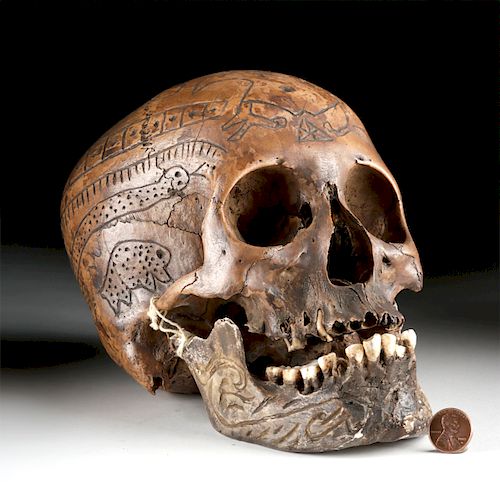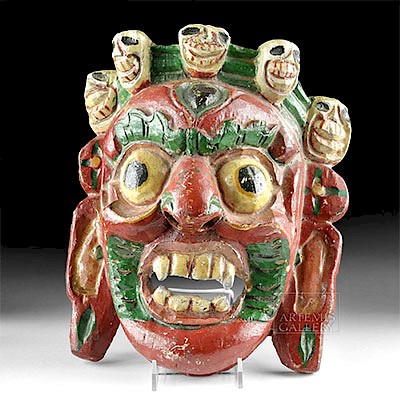Early 20th C. Dayak Incised Trophy Skull - Ndaokus
Lot 141b
About Seller
Artemis Fine Arts
686 S Taylor Ave, Ste 106
Louisville, CO 80027
United States
Selling antiquities, ancient and ethnographic art online since 1993, Artemis Gallery specializes in Classical Antiquities (Egyptian, Greek, Roman, Near Eastern), Asian, Pre-Columbian, African / Tribal / Oceanographic art. Our extensive inventory includes pottery, stone, metal, wood, glass and textil...Read more
Estimate:
$2,500 - $3,500
Absentee vs Live bid
Two ways to bid:
- Leave a max absentee bid and the platform will bid on your behalf up to your maximum bid during the live auction.
- Bid live during the auction and your bids will be submitted real-time to the auctioneer.
Bid Increments
| Price | Bid Increment |
|---|---|
| $0 | $25 |
| $300 | $50 |
| $1,000 | $100 |
| $2,000 | $250 |
| $5,000 | $500 |
| $10,000 | $1,000 |
| $20,000 | $2,500 |
| $50,000 | $5,000 |
| $100,000 | $10,000 |
| $200,000 | $20,000 |
About Auction
By Artemis Fine Arts
Apr 25, 2019
Set Reminder
2019-04-25 10:00:00
2019-04-25 10:00:00
America/New_York
Bidsquare
Bidsquare : Pre-Columbian | Tribal | Ethnographic
https://www.bidsquare.com/auctions/artemis-gallery/pre-columbian-tribal-ethnographic-4035
Featuring ancient and ethnographic art from around the world, including Pre-Columbian, Native American, African / Tribal, Ethnographic, Spanish Colonial, Fossils, Fine Art, much more. Artemis Fine Arts info@artemisfinearts.com
Featuring ancient and ethnographic art from around the world, including Pre-Columbian, Native American, African / Tribal, Ethnographic, Spanish Colonial, Fossils, Fine Art, much more. Artemis Fine Arts info@artemisfinearts.com
- Lot Description
Southeast Asia, Indonesia, Borneo, Central Kalimantan, Dayak peoples, ca. early 20th century CE. A beautiful example of a headhunter's trophy skull, known as an "ndaokus," adorned with intricate linear, zoomorphic, and anthropomorphic motifs. An elongated cresting wave is presented on both sides of the mandible which is tied to the top of the skull cavity with string. Each lateral surface boasts a pair of abstract quadrupeds beneath a fork-tongued snake with stippled scales, and a bulbous frog is displayed along the verso. A highly-abstract human figure stands with an upturned head, stocky conical 'wings,' a narrow waist, and avian-style feet, all beneath a small triangular symbol and enclosed within a wrapped border of dot-filled segments. Fine patina has developed along the exterior surfaces. Size: 5.375" W x 7.375" H (13.7 cm x 18.7 cm).
The Dayak people of old were feared hunters known for their occasional cannibalistic tendencies as well as their affinity and cultural attachment to headhunting. Young men would symbolically transition into manhood by being tasked with taking the life of an enemy combatant. This practice enabled young warriors to prove their masculinity and bravery by taking possession of the soul of the slain foe. The collected skulls were kept in the house of the hunter as trophies, proof of their prowess as a warrior. Ndaokus skulls generally lack a lower jaw because the mandible was removed and given to the women as necklace pendants for a penultimate insult toward the defeated enemy.
Provenance: ex-private Thousand Oaks, California, USA collection
All items legal to buy/sell under U.S. Statute covering cultural patrimony Code 2600, CHAPTER 14, and are guaranteed to be as described or your money back.
A Certificate of Authenticity will accompany all winning bids.
We ship worldwide and handle all shipping in-house for your convenience.
#145679Mandible repaired from three large pieces with light adhesive residue along break line. Mandible is likely not original to top of skull. Restoration to areas of nasal bridge, cheek bones, and orbital cavities, with resurfacing and overpainting along new material. Minor abrasions to top and sides of skull and mandible, with light softening to some incised details, and light encrustations. Nice earthen deposits and fine patina throughout. Mandible attached to top of head with modern string.Condition
- Shipping Info
-
All shipping is handled in-house for your convenience. Your invoice from Artemis Gallery will include shipping calculation instructions. If in doubt, please inquire BEFORE bidding for estimated shipping costs for individual items.
-
- Buyer's Premium



 EUR
EUR CAD
CAD AUD
AUD GBP
GBP MXN
MXN HKD
HKD CNY
CNY MYR
MYR SEK
SEK SGD
SGD CHF
CHF THB
THB















